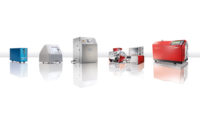Why leak test? Leak testing is performed to ensure that when in service, the component or assembly has zero leakage or a leakage that is acceptable over time for the fluid/gas that it is meant to contain, or conversely to prevent material on the outside from leaking in. A component or assembly leaking in operation above the limit specified would at best incur the cost of replacement, tarnishing the manufacturer’s reputation and at worst may lead to a devastating failure of the system. One point to note is that all things leak to some degree, however, the reason to leak test is not to stop all leaks but to test to a standard that will ensure the tested part will not leak the product inside or not exceed an allowable leak rate in service. The test method chosen to perform this critical test requirement that ensures a part does not leak is dependent on many factors including:
(a) The direction of leak – from inside out or from the outside in.
(b) The media contained inside the part and if the requirement calls for zero leakage or an acceptable leak rate over a time period.
(c) The viscosity of that substance that the part will contain in service – this will be a major contributor in calculating the sensitivity required of the test.
(d) The pressure that the test piece will see in service – particularly important when the part is flexible or features O ring joints that may move and reset at variable pressures.
(e) The requirement to measure the total leak rate (global test – chamber test) or to pinpoint the leak site (sniffing).
(f) The internal volume of the test piece.
(g) The hole size that has been determined to prevent the substance from leaking out or into the test part or assembly.
Most suppliers of leak detectors can help you calculate the test requirement for specific applications based on the information above. Calculations are based on proven documented theory and the experience of the leak test manufacturer in testing similar components /assemblies.
SELECTED TEST METHODS
The most basic form of leak testing is to pressurize the part with air and then either dunk into a water tank or to spray a soap solution around the suspect areas looking for bubbles. The test is labor intensive, lacks sensitivity and may contaminate the part. Today’s electronic leak test technology is far less labor intensive, clean, sensitive, provides a direct reading of the leak rate, and can be documented. Most importantly it can be fully integrated into an automatic production process.
Electronic leak testing can be separated into two major groups: (a) tracer gas leak testing (b) air decay/flow leak testing which can only be used to determine the overall leak rate (global test). The air technique is typically used for less stringent applications, for example, to ensure a small part will not leak a viscous fluid such as water or oil. The air decay/flow test method has many applications in the high volume production automotive market, but far less in the aerospace industry where components tend to be large and where a higher sensitivity is required. As components and assemblies in the aerospace industry are manufactured on a much smaller scale than automotive and therefore more expensive, locating the leak for later repair is essential. To address the sensitivity and leak location requirement for testing in the aerospace industry, the leak test is typically performed using a tracer gas such as helium or diluted hydrogen. The detectors most commonly used are mass spectrometers.
Advantages of a mass spectrometer leak detector:
- High sensitivity to detect the smallest of leaks
- Global (chamber) or pinpoint leak testing (sniffing) capabilities
- Testing of large or small component volumes
- Is not affected by temperature variations
- Can be utilized in a manual or automated test process
- Provides full test data recording for traceability of the test
- Traceable NIST calibration
APPLICATIONS IN THE AEROSPACE INDUSTRY
Tracer gases have been used in the aerospace industry for many years for testing the following components and assemblies:
- Gas lines
- Fueling systems and tanks
- Sealed electronic enclosures
- Missile guidance systems
- Antennas
- Gyro assemblies
- Solid rocket booster cone assemblies
- Heat exchangers
- Valves
- Hydraulic systems
LEAK TESTING TECHNIQUES, APPLICATIONS AND TYPICAL LEAK RATE CRITERIA
There have been many advances in the detectors used for tracer gas leak detection in production over the past few years including:
- Enhanced filament material technology to improve reliability and sensitivity
- Simplified user/machine interface
- Enhanced vacuum pump technology to improve performance, reliability and speed
- Improved test data recording capabilities for traceability of process
- Wider product offering with detectors specifically designed to fit the application
- Improved protection against misuse or test failures
To sum up, due to a vibrant mature leak detection industry, there will be a leak detection process that will be suitable for your specific application. The factors detailed earlier, together with consultation with the leak test manufacturer, will ensure the leak test process selected provides the quality you demand at an affordable cost.
REDUCING COST/TEST BY RECOVERING THE TEST GAS
Depending on the sensitivity requirement of the test, it will somewhat dictate the concentration of the tracer gas used. For higher concentrations of helium it may be more economical to recover the gas used for the test so it can be reused. There are systems in the market that can recover up to 98% of the gas used for a specific test.


